Blog

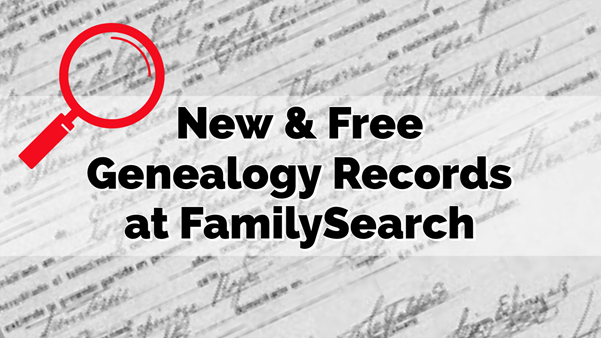
New Free Genealogy Records and Images at FamilySearch
When new genealogy records come online, they can be in different forms. Sometimes they are indexed records and sometime they are browse-only digital images.
Either way, new genealogy content online is always welcome. And this week this new content is free thanks to FamilySearch.
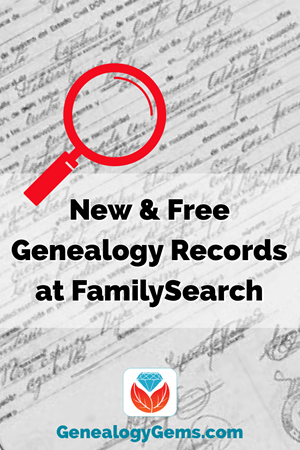
Don’t let the fact that some of these genealogy records are currently browse-only images. in our article Browse Only Databases at FamilySearch are Easy to Use, we’ll help you navigate these types of records. It’s not difficult to do, and the rewards can be big.
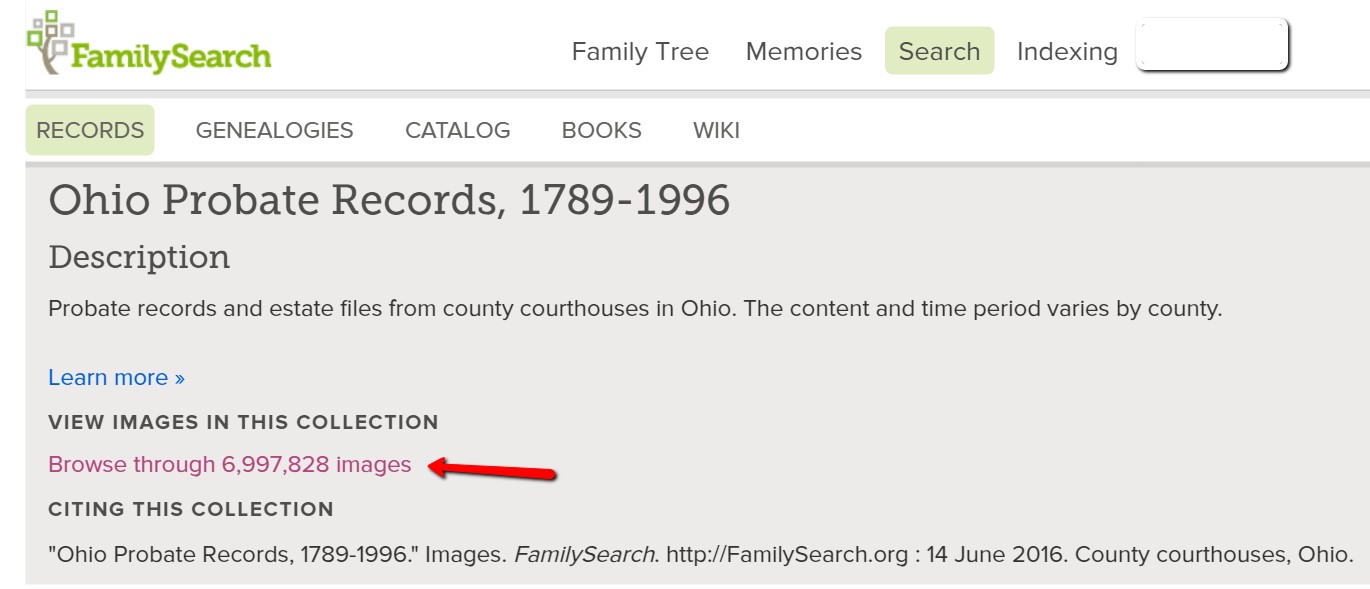
Example of accessing browse-only digital images at FamilySearch
If you haven’t used FamilySearch before, all it requires is that you sign up for a free account which you can do here at their website.
Here’s the latest press release from FamilySearch detailing the newest content.
SALT LAKE CITY, UT—FamilySearch.org added over 13 million new, free, unindexed digital images of historical Italian records this week from Avellino, Belluno, Caserta, Matera, Verona, and Vicenza, Italy. Other indexed records include areas from Brazil, Germany, Peru, South Africa and the United States, including Alabama and Kansas.
Click here to search over 8 billion free names and record images catalogued on FamilySearch.
(Find and share this announcement online from the FamilySearch Newsroom.)
Brazil
Brazil, Pernambuco, Civil Registration, 1804-2016
Indexed records: 162,706
Added indexed records to an existing collection
Brazil, São Paulo, Civil Registration, 1925-1995
Indexed Records: 199
Added indexed records to an existing collection
Germany
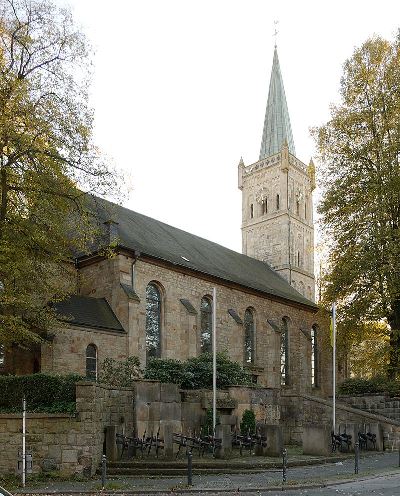
Germany, Baden, Archdiocese of Freiburg im Breisgau, Catholic Church Records, 1678-1930
Indexed records: 1,045,113
Added indexed records to an existing collection
Germany, Bavaria, Diocese of Augsburg, Catholic Church Records, 1615-1939
Indexed Records: 383,480
Added indexed records to an existing collection
Italy
Italy, Avellino, Civil Registration (State Archive), 1809-1947
Digital Images: 3,099,458
Added images to an existing collection
Italy, Belluno, Civil Registration (State Archive), 1806-1815
Digital Images: 43,298 New browsable image collection.
Italy, Caserta, Civil Registration (State Archive), 1809-1866
Digital Images: 4,543,698
Added images to an existing collection
Italy, Matera, Civil Registration (State Archive), 1809-1925
Digital Images: 1,323,614
New browsable image collection.
Italy, Verona, Civil Registration (State Archive), 1630-1942
Digital Images: 2,796,910
New browsable image collection.
Italy, Vicenza, Bassano del Grappa, Civil Registration (State Archive), 1871-1942
Digital Images: 1,637,660
Added images to an existing collection
Peru
Peru, Lima, Civil Registration, 1874-1996
Digital Images: 175,257
Added images to an existing collection
The records newly added to this collection have not yet been digitized. Click the clink at the bottom of the search page to browse.
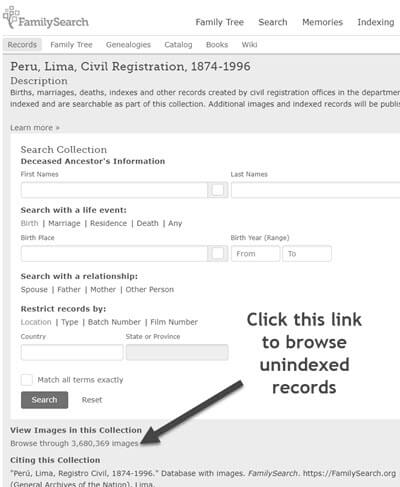
Click to browse genealogy records from Peru
Here’s an example of what these Civil Registration record from Peru look like:
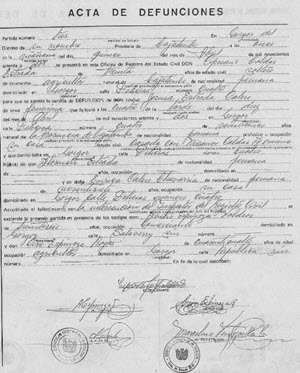
Example of Civil Registration records from Peru
South Africa
South Africa, Natal, Passenger Lists, 1860-1911
Indexed Records: 154,091
Added indexed records to an existing collection
United States
Alabama, Jefferson County Circuit Court Papers, 1870-1916
Indexed Records: 30,070
Added indexed records to an existing collection
Kansas, Grant County, Census Records, 1895-1982
Indexed Records: 87,928 0
New indexed records collection
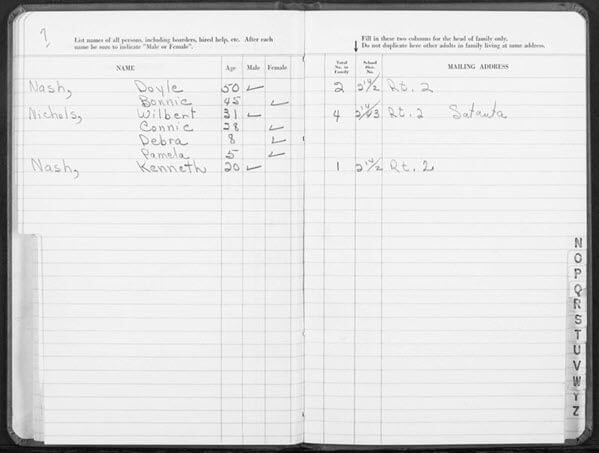
An example of a record from the Kansas Grant County Census Record Collection
United States Census, 1880
Digital Images: 13
Added images to an existing collection
United States, Cemetery Abstracts
Indexed Records: 179,757
Added indexed records to an existing collection
Share Your Findings
Did you find a genealogy gems in one of these new records at FamilySearch? Please leave a comment below.

French Genealogy: Filae.com launches English language site
Filae’s French collection opens the door for non-French-speaking people to discover their family stories online.
40 million people in the world (excluding France) claim French descent. Here’s the latest press release from Filae:

Paris, France – September, 18, 2019 – Filae.com, the world’s largest online resource for accessing French official records, today announced the launch of its first foreign language international sister-site: https://en.filae.com
With more than 40 million people in the world claiming French heritage, the launch of an English language version of Filae.com gives all of them an unprecedented and exclusive access to more than 150 million images of French Census and Vital records (birth, marriage, death) which have been indexed by Filae.com.
As Elvis Presley, Alec Baldwin, Angelina Jolie, Jessica Alba, Kurt Cobain, Warren Buffett, and many other celebrities, 4% of the US population, 17% of Argentinians and 14% of Canadians have French roots!
“The launch of Filae.com is just the beginning of a more global strategy whose aim is to facilitate access to the largest resource of French records and to help people with French descent tracing back their ancestry whatever their language is and wherever they live! We are thrilled to share information we digitized and indexed with family history fans all over the world.” said Toussaint Roze, CEO and founder of Filae.com.
Starting as early as 1500, Filae’s French historical collection features records such as:
- Parish registers,
- Civil records,
- Census and vital records,
- Passenger lists,
- Military records (Napoleonic wars, WWI, WWII),
- Indexes provided by French societies,
- Directories
- and many other historical records (French revolution, etc.)
Filae.com also provides its users with easy-to-use tools to build their own trees or import their gedcom files, upload photos and documents and share them with other members.
Here’s a look at the Filae website:
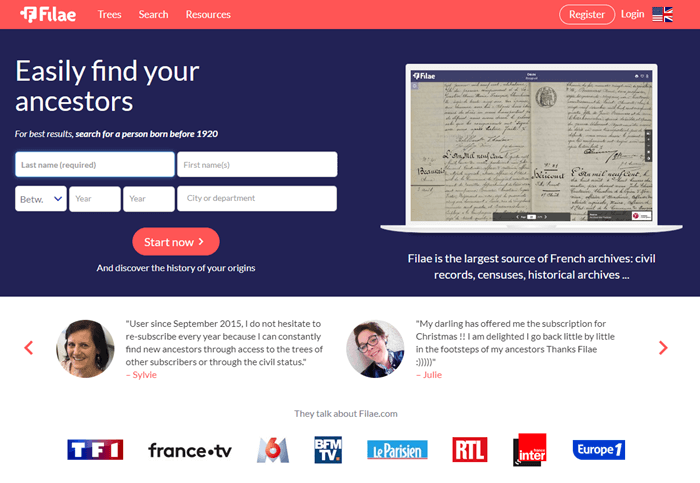
About Filae.com
Launched in December 2016, Filae.com is the first and largest resource for French digitized and indexed records online.
The service was created by Toussaint Roze, a French serial- entrepreneur dedicated to genealogy who previously created successful online services like notrefamille.com, genealogie.com and gedlink.
Filae.com hosts and indexes more than 150 million digitisations of French original records for the XVIIIth and XIXth centuries.
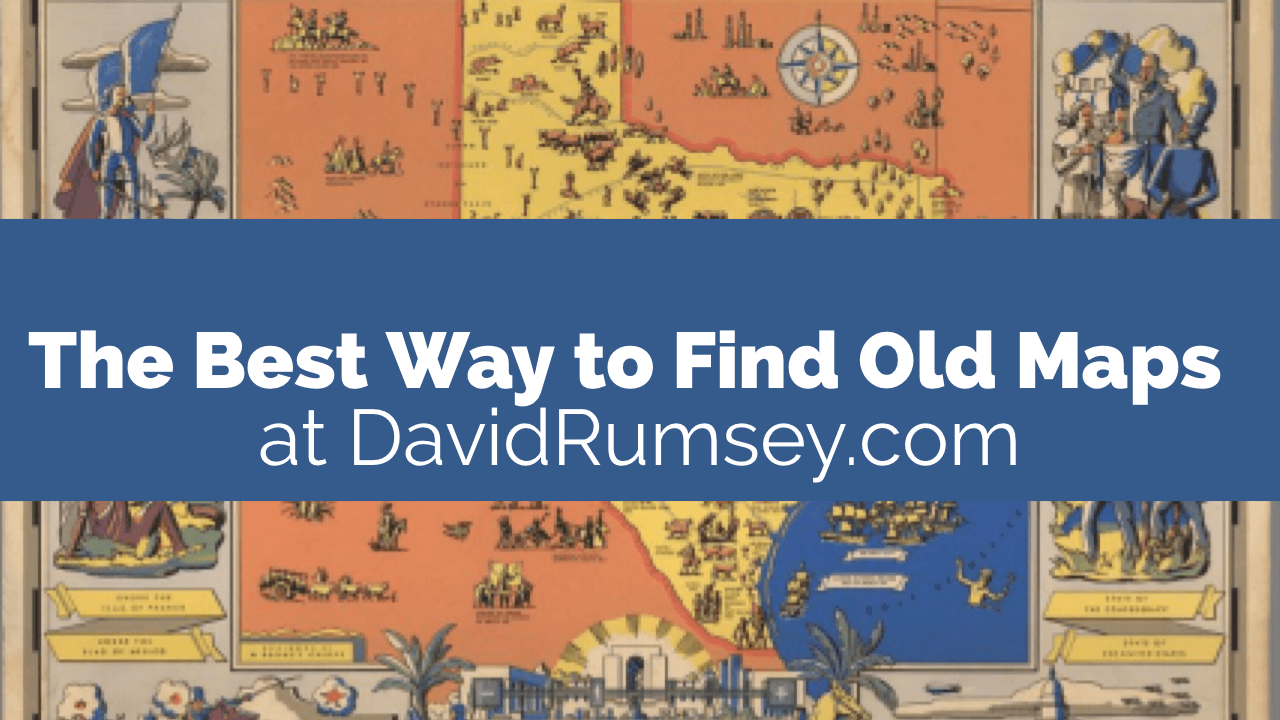
The Best Way to Find Old Maps for Genealogy at the David Rumsey Website
Old maps are vitally important for genealogy because the characteristics of a location can change in many ways over time. Historic maps help us understand the world as it was at the time our ancestors lived.
Here is a short list of just a few of the things that may have changed:
- Street addresses
- roads
- town names
- county boundaries
- waterways that may have been filled in or opened up
- railway lines
In fact, the country itself where they lived may be a completely different country. For example, my German ancestors lived in Prussia in the 19th century. Today, that area is part of Poland. Therefore, all of the village names have been changed to Polish names.
The David Rumsey Map Collection is an excellent place to go to find maps of your ancestors homeland for free.
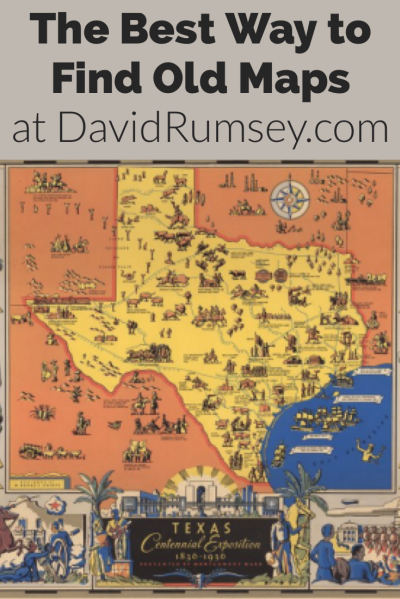
Watch the Map Search Video
I’m going to explain the 7 steps to finding the maps you need for your genealogy research at this wonderful website! I highly recommend that you watch the short video below to see it in action as you read. The player will stay with you as you scroll down the page.
Step 1: Go to the David Rumsey Map Collection Website
The first thing you need to do is go to the David Rumsey website here. You’ll be greeted on the home page with glorious historic maps. (Stay focused because it’s easy to get distracted by all the fascinating maps!)
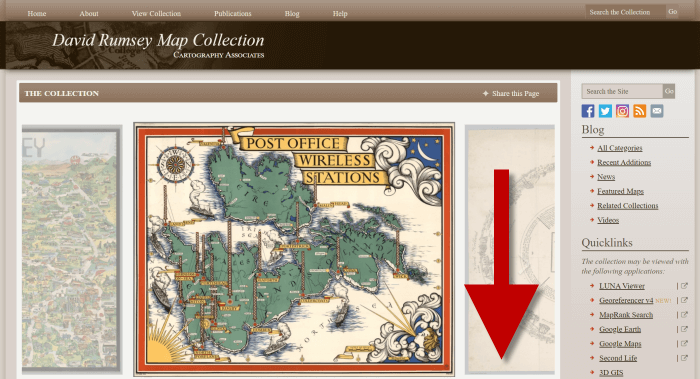
Scroll down on the David Rumsey website home page.
Step 2: Scroll Down to the Bottom of the David Rumsey Home Page
While you can search for a place name in the search box at the top of the page, there’s a better way to search. Scroll down the page until you get to Featured App: MapRank Search (it’s almost at the bottom.)
Step 3: Launch Map Rank Search
The Featured App – MapRank Search is the best place to search the website, but it’s easy to miss because it’s not at the top. So go ahead and click the Launch MapRank button in the upper corner of this section.
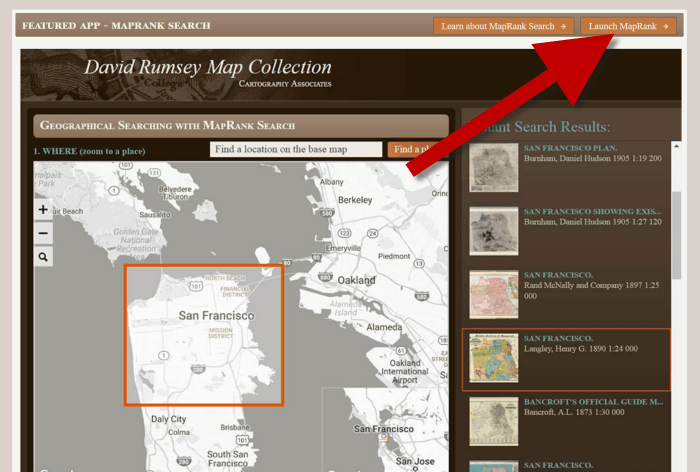
In the Featured App: MaprRank Search section click the Launch MapRank button
When you click the button it will open a new tab in your web browser which will take you to the Geographical Searching with MapRank Search page.
Quick Tip: The Fastest Way to MapRank Search
You can get there faster by going directly to https://rumsey.mapranksearch.com. I didn’t take you straight there from the beginning because I think it’s important to be aware of the home page and everything else it offers. However, today our focus is conducting the optimal search for old maps for you family history.
Step 4 Selecting the Map Time Frame
Here’s what the search page looks like.
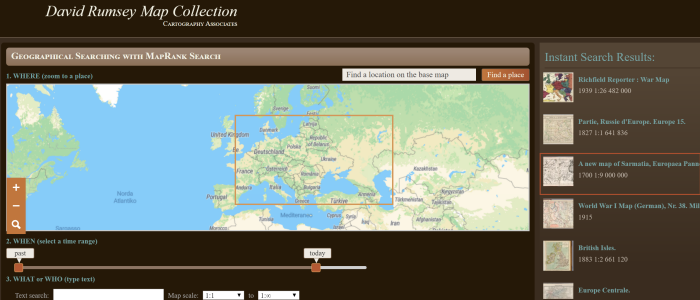
The DavidRumsey.com search page
There are two very important features on this app page that will help you get the best results possible: the time slider and the location search box.
The time slider is located beneath the map:
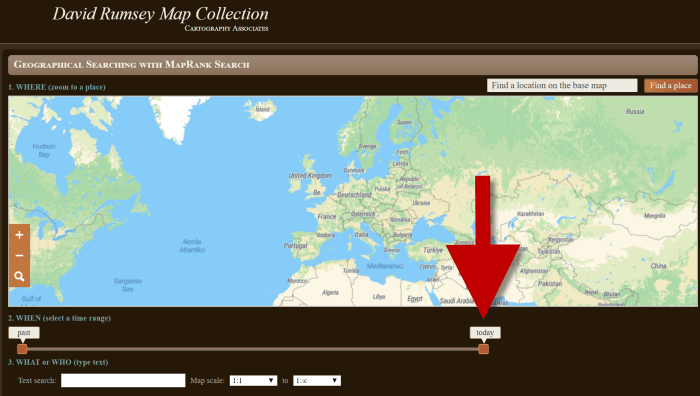
Time Slider for searching maps by time frame
It’s important to first select the time frame that you are searching because that will dictate the results you get when you search on the location name. (We’ll get to that in just a moment.)
There is a slider on each end of the timeline. Slide them to specify the desired time frame. In my example below, I’m looking for maps between 1800 and 1900.

Searching for maps between 1800 and 1900
As you move the sliders, you’ll notice that the maps in the right hand column will change. This is because only maps that fall within the range you select will be offered in the Instant Search Results column. But before we look at those, we need to type in a location in the next step.
Step 5: Selecting the Location
With your time frame selected, now you’re ready to type the location in the search box.
As you type, the app will make suggestions. But wait! Before you click the Find a Place button to run the search, look carefully at the list of suggested locations that may appear. Many locations names can be found in different areas. That is certainly the case with the name of the tiny village where my great grandfather was born: Kotten.
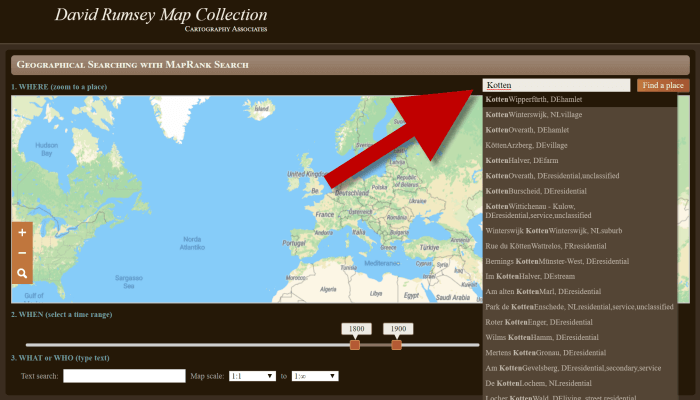
Type the location name to search the maps
In fact, the list doesn’t even include the Kotten I am looking for.
In cases like this, it is best to search a little more broadly. When Kotten was part of Prussia, it was located in Kreis Johannisburg so I could try searching for that. Even better might be to search for the largest city in the area since Kotten was such a tiny village. Arys was the largest city in the area.
Once you type in the name (and select from the suggestions if needed) click the Find a Place button just to the right of the search box.
Step 6: Analyze the Map Results
In my example of searching for the city of Arys (which is the name it was known by in the 19th century when it was part of East Prussia) the modern-day map displayed is actually Poland.
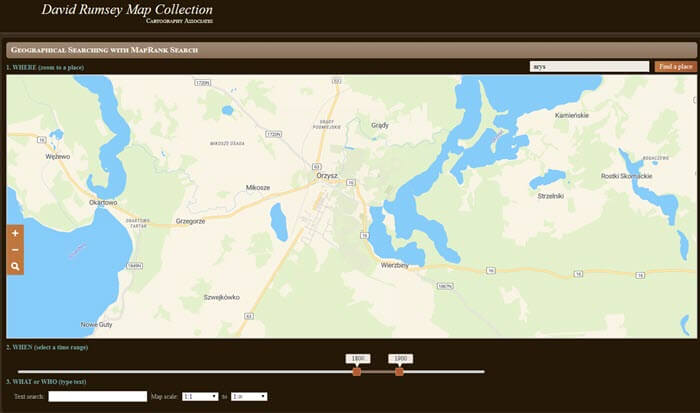
My search resulted in a map showing Orzysz, Poland
However, the David Rumsey website does a good job of cross-referencing the older German names (Arys) with the new Polish names (Orzysz). This is another reason why searching for a larger city works well. Larger cities are more likely to be in the David Rumsey system for cross-referencing, and of course they are easier to spot on the map. Generally speaking, the location you searched will be in the center of the display map.
Quick Tip: Verifying Location Names
Another quick way to cross-reference location names (or verify your findings in David Rumsey) is by searching for the name in Google Earth. In the example below, I typed in the Prussian city of Arys. Google Earth will offer options if more than one matching result exists.
I was a bit surprised to see “Arys” as one of the three listed results since it is not called that today. When I clicked Arys it took me to the city of Arys in the Turkistan Region of Kazakhstan, far away from Poland! Clicking Orzysz in the results list took me to the area of Poland that was once East Prussia. This confirms the results I received at the David Rumsey website.
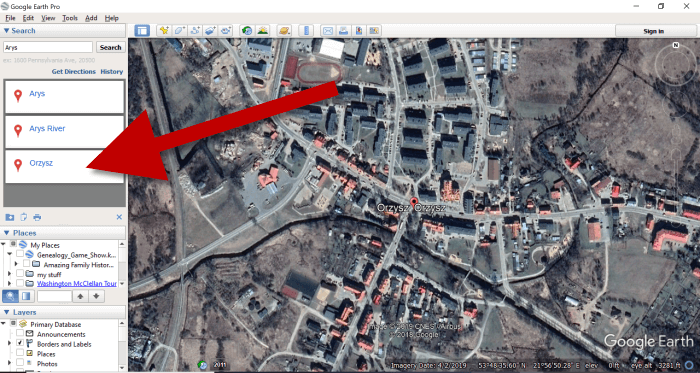
Learn more about using Google Earth for Genealogy by watching my free class here.
Now it’s time to review the map results listed in the Instant Search Results column on the right. Isn’t it fantastic that David Rumsey’s website not only presented me with the correct Polish location, but also maps published between 1800 and 1900 that include Arys? I think so!
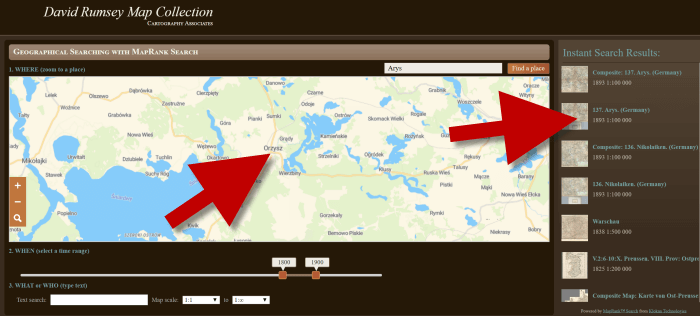
Map results appear in the column on the right side of the page.
Click the map you think best suits your needs. The map will open in in a new tab in your web browser. (These browsers tabs provide a nice bread crumb trail for your searching activities.)
All of the source information about the historic map that you chose will appear in the column on the left. (See the image in Step 7.) If you decide to use this map you’ll definitely want to accurately cite the source. Learn more about the importance of source citations here.
Step 7: Export the Map
I was delighted to find the village of Kotten on this map of Arys published by Reichsamt fur Landesaufnahme in 1893!
When you find a map that you would like to use for your family history research, export it to your computer. To do this, click Export in the upper right corner of the map and select the desired size. You can select a size ranging from Small Thumbnail to Extra Extra Large. Keep in mind that the larger the size, the more clarity you will have as you zoom in closer and closer. This is very important if you plan on using the map in an overlay in Google Earth. You can learn how to create your own map overlays in my video tutorial series on using Google Earth for genealogy available here, and in my book The Genealogist’s Google Toolbox.

Click “Export” to save the map to your computer.
Be patient while downloading to your computer because it can take several moments to export a large map. The saved file will probably be zipped. To unzip it, on a PC right-click and select Extract All from the pop-up menu. This creates an open version of the folder containing the map.
Get Started Finding Your Ancestral Locations in Old Maps
With this step-by-step process you are now ready to explore any given ancestor’s world through the rich details of historic maps. I can’t wait to hear what you discover! Please be sure to leave a comment below. And if you found this tutorial helpful, will you please share it with your friends on social media so we can help even more people find the homes of their ancestors? Thank you!





